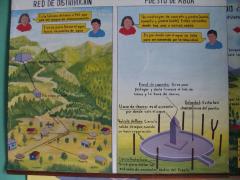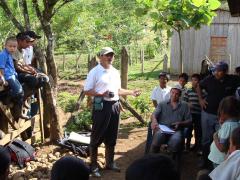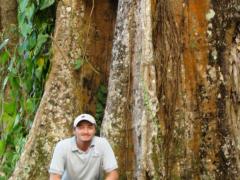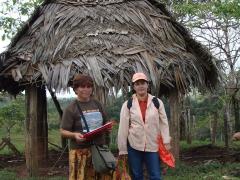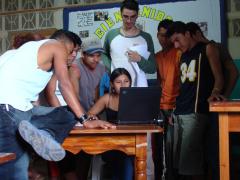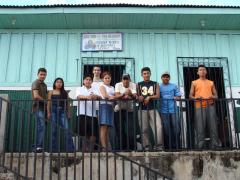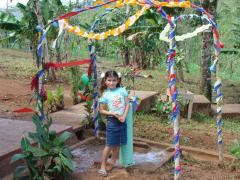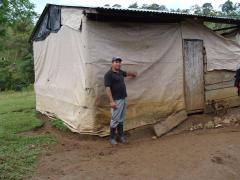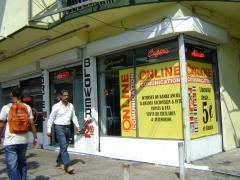Agua Para La Vida visit in Rio Blanco, Nicaragua
Following are the articles we wrote after visiting the amazing Agua para la Vida ("Water for Life") project in Rio Blanco, Nicaragua. We're amazingly impressed with them, as you can see :-) You can view all the pictures from our visit here.
¿Hablas español? Hay una traducción malísima de esta página aquí.
Agua Para La Vida: We're in Rio Blanco, Nicaragua
Last Tuesday we rode into Rio Blanco, in the rural, rural lowlands of Nicaragua, to visit an organization we'd been in contact with for a few years, so we'll be in Rio Blanco for a week or so. Agua Para La Vida (Spanish for "Water for Life") was founded 19 years ago toward the end of the dark war years when a CU Berkeley engineering professor came to this out-of-the way place for a visit with another charitable organization and found that there was no potable water at all in the village he was visiting. Being an engineer, he thought in terms of how to solve their problem with some water engineering, and he brought volunteers to the village over a period of a couple of years to put in a water system, complete with collection at the water source (a spring) and piping to distribution points. From that time to now APLV has grown into a modest but effective little organization, having completed more than 50 projects in the little villages mostly in the Rio Blanco area.
APLV has an integrated approach to water: They don't want to just deliver a water project, because without the other aspects of healthy living it doesn't do much, and won't be cared for properly anyway. They work with the community to make sure that each household member gets trained in a variety of health management techniques, including handwashing, proper storage and handling of drinking water, trash management, and the like. And each household gets an outhouse; normally in these villages there are very few outhouses, and you can imagine the health impact of having no sanitation facilities at all. Finally, APLV works with the community on reforestation of the area around the water source, for two reasons. The first reason is that it's important to get a tree-covered area around the source to prevent cattle or other animals from fouling it. But even more important is that the source will have a tendency to dry up in the future if proper vegetation is not maintained in the micro-watershed that feeds the spring.
We contacted APLV before heading this way and offered to help out where we could with computer issues, GPS management, and Autocad, and they put us right to work - it's quite a pleasure to see such a cadre of enthusiastic workers. Sometimes the workers in an organization like this can get a bit jaded or discouraged, working just as employees, but these people are all giving it their best, retaining their enthusiasm and commitment even after a decade or more on the job.
It's interesting to see too how humble an organization it is (in the good way). They've always maintained a commitment to making sure that every dollar goes to the project, to items of value, instead of to overhead. So their office is not with the other NGO offices on the main street, and definitely does not have a fancy storefront. It's just a nondescript warehouse-type facility on a back street (a dirt street, like most of the streets here) and has a simple sign.
Due to this same philosophy, APLV does not follow the signage practices of the other NGOs doing various projects here. (There are dozens of NGOs, or Non-Government Organizations, working here - you see them everywhere.) Most of the NGOs post a prominent sign after they complete a project, with an explanation of the project and the logos of all the NGO participants. We've seen these signs in little villages way out in the sticks ("100 outhouses, care of the European Union and World Vision", "Improved road, courtesy of the government of Japan", etc.) But APLV doesn't even put up a sign when the project is completed, for two reasons: First, because they want the dollars going to the project, not to a sign about APLV. Second, because the reality is that the water system and associated benefits are not just a gift. They are a cooperative venture in which the community has participated fully.
APLV: Home-Grown Leadership
Esteban Cantillano is one of the amazing success stories of APLV. In 1993 he was a campesino living in a little, remote village where APLV was developing a potable water project. He was elected the coordinator by the community, so was responsible for all the interface with the community. But he asked a pile of questions of the brigade from UC Berkeley that was putting in the system! He wanted to know about everything. He was eventually invited to join the first class of the "Potable Water Technical School", a technical high school program, but protested that he had only finished the 6th grade. They said "well, try it out - we'll take you on probation." That was in 1993. Needless to say, he finished with honors (and later went back and did his 7th-10th grade education!) and became one of the pillars of APLV. He has served in the technical/design role he was trained for, as the social coordinator (who does the contact with the village, local government, landowners, and the like), and is now in charge of the office here in Rio Blanco. He seems to know everybody, and to know everything about every project ever constructed by APLV.
Esteban is just one example of the depth of leadership that we've found here. All but one of the workers here is Nicaraguan, and they have a combined total of decades of experience with the organization. Many times an organization like this is directed from outside the country, and the workers are just salaried workers, doing the best they can, but for them it's a job. In this case we have local people who are fully invested in the past, present, and future of the organization. We're pretty optimistic about the future.
Agua para La Vida's in-country director is Carmen Gonzalez, who has been here for 3 years after 15 years with Habitat for Humanity, where she was involved with the building of hundreds of houses for needy Nicaraguans. In keeping with APLV's philosophy of putting money into projects rather than into comfortable surroundings and administrative costs, Carmen runs the national office out of her small house in Managua, with no administrative help, just her. She spends 2-3 weeks each month in Rio Blanco (four hours away by bus) living in the very modest home where we're staying right now (outhouse, running water and electricity but no hot water).
Her vision is to change APLV from an isolated organization dependent on aid from a few donors in the US and France into a robust, Nicaragua-centered NGO (the techie term for Non-Government Organization, or charity working in country). She's trying to establish new and sustainable funding sources and is trying to establish links with many other NGOs and to do joint projects, etc.
We certainly applaud this approach - when we were working with Friendship Bridge in Guatemala we went to one village where the women were all telling us that their young children were ill. They said that almost every child under age 2 was perpetually sick. But Friendship Bridge is a microfinance organization and at least the on-the-ground workers have no idea what health resources might be brought into play for this group. This seems to be a constant problem in Central America (and perhaps throughout the developing world) and so we certainly applaud the idea of building ways to solve problems which may be outside the purview of any particular organization.
Carmen also wants to make sure that APLV, while maintaining its efficiency and humility, can perform at the level of professionalism required by the various funding sources. They might be a great organization, but if they can't demonstrate that to a particular NGO funding source by showing that they execute in a professional manner, that fact could cut them out of the ability to do a number of projects.
Agua Para La Vida: The Community does all the work!
(We'll have pictures and updates to this article in a couple of days.)
When a community gets interested in a water project and approaches APLV, it has to go through a number of steps before the project can become a reality. One of the first steps is to commit to doing all of the unskilled labor and provide hospitality to the APLV technical staff when they are onsite. Although APLV provides the materials and engineering, the community does an extremely difficult job - each family normally commits to between 42 and 62 days of labor for the project. You can imagine what that means to people who have very little to take that much time out of the course of a project (6 months to a year). The families build their own outhouses, and the men do all the trenching and the concrete work. This is a pile of work, as the piping often runs for 6-9 miles (10-15 kilometers).
If you're interested in more information on Agua Para La Vida or would like to contribute, they have an excellent website at APLV.org where you can get the whole scoop or make a contribution. It takes just $30,000 to $60,000 to fund a complete village project that may benefit 100-200 families, complete with potable water, outhouses, community health training, and reforestation planning. It is even possible to fund an entire project (and then visit for the inauguration of the project), but of course most of us give in smaller chunks. If you have the means, we encourage you to talk with them about funding an entire project, since they have a couple for which the study, paperwork, and planning are already done and all that remains is to find the funding.
APLV: Reforestation and Environmental Work
The second day we were in Rio Blanco at APLV in Rio Blanco Fadir Rojas, APLV's reforestation engineer, took us for a hike up into the beautiful Cerro Musún wilderness reserve right next to the town, where he used to work as an engineer and ranger. We spent the afternoon climbing up into virgin forest to a beautiful waterfall called Cascada Las Golondrinas (the swallows). As we walked along we chatted about his responsibilities with APLV and the growing importance of reforestation within the goals of the organization.
Fadir is from a purely campesino family in the dry, heavily populated western part of the country. His parents barely went to school - perhaps to the first grade - and can't really read, but they pushed education in their family and Fadir is one of four university graduates in his family. He succeeded in getting full scholarships for his university education at the national university and is now, at 27, one of the elite young leaders of Nicaragua.
When Fadir came to APLV he found that their vision of reforestation was too limited: They understood the idea of using forest management to project the water source from contamination, but the integrated management plan did not include enough emphasis on protecting the watershed itself from deforestation. Of course any spring depends on the waters beng gathered by its watershed, and will dry up if all the trees are cut to provide pasture for cattle, or if all the upstream land is pressed into an inappropriate type of service.
So Fadir is trying to enhance the current protection model of reforestation with an additional watershed management model. He's a bright young man with a great grasp of what's going on and we think he'll succeed.
APLV: Promoting Health and Sanitation
The organization we visited in Rio Blanco, Nicaragua, Agua Para La Vida, believes in an integrated approach to making a difference in a community. So they don't just drop a potable water system and disappear. They try to set up a program that will be self-sustaining and which can make a long-term difference in the health and welfare of the community. For that reason they always provide an outhouse (actually constructed by the family), and have a health team in charge of evaluating the community's needs, training them in appropriate health practices, and monitoring the water quality of the installed system.
Lilian Bando and Gregoria Espinoza have been working for APLV in their role as health promoters for a dozen years, and they still find that their educational role is the most important thing they do.
When they arrive at a new project, it's quite common to find that there are few or no outhouses (of course there are no sewage or water systems, so outhouses, where they exist, are the workhouses of sanitation in rural Central America). And it's also common to find that the entire community is ignorant of basic concepts like handwashing after going to the bathroom, proper management of drinking water, appropriate disposal of trash, and the like. There are an awful lot of villages where defecating out back and letting the pigs and chickens clean up is normal, and that's not good on the health front.
Lilian and Gregoria have an entire health evaluation routine that they do at the beginning and at delivery of a project, and they they spend the bulk of their efforts doing group and family-by-family training on the critical aspects of health practices. By the end of their routine the practices and the health of the community can be much improved.
I was working with these two helping with a spreadsheet that analyzed the before and after health practices and statistics. According to these numbers, the instance of childhood diarrhea in the village we were analyzing dropped by 50-70%, which is a pretty amazingly good number. It's no surprise that the basic answers to "do you wash your hands after going to the bathroom and before eating" had improved amazingly as well.
Once again, it's a treat to see two women who have been working together on the same mission for more than a dozen years sticking to it with an impressive intensity and compassion. They only thing that really gets them down is when they work with a community that has so little to eat that it seems they need that before working on sanitation issues. Sometimes, they say, they just wish they could give out nail clippers to the families that can't even afford one.
APLV: The Potable Water Technical School
Agua Para La Vida is committed to truly sustainable solutions, and they have demonstrated it in the most significant way by actually starting a school for Potable Water Technicians.
The initial little tiny project that APLV did back in the 1980's, of course, was mostly done by brigades of volunteers coming down for a few weeks at a time. But when you do that, your project has little hope of being maintainable, because there is inadequate in-country expertise. To counter this, APLV started up the "Escuela Tecnica para Agua Potable", or Technical School for Potable Water back in the 1990's. It's a fully accredited 2+ year class involving every aspect of potable water design and development, including the theory and practice of planning and engineering the delivery systems and including everything else that APLV does with a project. Three classes have now graduated, and the fourth class (of 8 students) is about halfway through. For this class, 70 students from all over Nicaragua applied for the full-ride scholarship (including room, board, and tuition), and just the 8 slots were available. But what an education they get. They come out with all the mathematics and engineering to do technical work on water systems, and have a fully-accredited "Bachelor" degree, similar to an honors technical high school degree. Their presence in various organizations throughout Nicaragua means that projects don't have to spend money on high-priced consultants to do the work that these specialized technicians can do. APLV's "ETAP" school is the only school graduating water technicians in Nicaragua.
The school has typically been taught by workers who come from abroad to do a year or so of duty. The first group of students was taught by the founder of the organization on various trips to Nicaragua. This past year the curriculum has been taught by a talented French graduate engineer, Gilles Burkhart. Now that the school has matured, Gilles has a full building for the students, including men's and women's dormitory areas and a well-equipped classroom including computers.
Gilles is about to move to other duties within the organization, and he'll be replaced for the coming year by another French engineer. At the end of this two-to-three-year cycle, yet another class of qualified, trained potable water technicians will be available to APLV and to rural Nicaragua at large.
APLV: Visits to actual communities getting water projects
We visited three impressive communities getting drinkable water in the Rio Blanco area. One was just in the preparation and funding stages, one was partly done, and the third was complete and beautiful, with a very remote community having clean, healthy drinking water 24 hours per day. I'll start with the one that was finished and work back to the one that was just about to get started.
Okawas
We had the delight of visiting the community of Okawás for the official ribbon cutting and handover ceremony for the new system. We got in a truck at 5;30 in the morning and drove for a couple of hours to a river crossing beyond which there was no road, crossed the river in a long motorized canoe, and then got on mules for the hour-long ride to the village. The trail started out pretty easy, but turned into some pretty impressive muddy and rocky ups and downs. With our little experience with horses we were a little nervous about how they were going to navigate the difficult terrain, but they did better than we would have.
Once there, the whole team went into action. Gregoria and Lilian, the health promoters, began to visit each household to check on how all the health education was going and to see if the outhouses were working out, etc. Most of the rest took the time before the celebration to go up and inspect the entire system, including the tank, the water capture point (a sealed-over spring), and the piping. It all looked mighty good, as did the beautiful outhouses.
After that, the celebration began. Everything was decorated, with crepe paper around one of the community water spigots. Everybody gathered for speech-giving and celebration, including a local mariachi band (who had come up on horseback with their instruments). Thierry Sciari, the representative of the French organization Res Publica that funded this project, met all the members of the committee. There was the presentation of certificates to each family acknowledging their contribution and their completion of the health and water use training. We were even asked to help with the presentation of some of these things, and asked to give a little speech ourselves, I guess as representatives of other APLV donors!
All in all, it was a wonderful celebration of a more wonderful event. Nancy talked to one gentleman who had had health problems (parasites) for years and years and had never been able to shake them before the new potable water system went in. But now, with good water available all the time, he is free of parasites and healthier than he's been in his life.
La Enea: A water system just going in
I got to visit the very ambitious water project being at the village of La Enea, which involves capturing the water from a creek high on the other side of a significant valley, bringing it down across the river and then back up the other side of the valley to the village.
This is a tremendously ambitious project, the biggest Agua para la Vida has ever undertaken. It involves the capture of part of a stream instead of just a little spring (and might require chemical treatment) and involves something like 37 kilometers of piping, seven kilometers for the basic water delivery and the rest for the distribution system.
And the water system will be a tremendous boon to this community, because they currently have to haul their (poor quality) water from a stream four kilometers away. So most either walk with a heavy load of water or perhaps load a burro with a big load. Imagine the time it would take out of your day if you had to personally carry all the water you needed for drinking, cooking, and clothes washing from a source two and a half miles away.
My visit was with an entire team from APLV, and there was a major status meeting with the entire community. Most of the meeting was about making sure that the proper amount of community labor was organized, since the community provides all the unskilled labor, as much as 50 man-days of hard labor per family. In the current stage of the project most of the work is using a pick and shovel to dig meter-deep trenches for the piping through rocky, rocky soil.
We left the APLV skilled water technicians there when we returned, since they were going to spend the week working with the community laborers to make another push on the distribution line. These young people are so talented and impressive. They almost all come from campesino homes all over Nicaragua and have graduated from the Potable Water Technical School that APLV runs and are now directing and overseeing impressive engineering ventures. All of them would be staying the week in simple accomodations provided by the locals, some a bit more rustic that most of you would appreciate. But no complaining from this talented group.
Monte de Cristo
The third village we visited was Monte de Cristo, which is a candidate for a water system and which may get one this year. We rode in the back of a truck for an hour and a half or so to get around the huge mountain that rises up beside Rio Blanco, then crossed a river on foot and rode horses for an hour and a half to the village, which is completely inaccessible by vehicle. As novices on horseback, it seemed nearly inaccessible on horseback! The steep, muddy inclines and deep mudholes seemed to us like they'd be too difficult for the horses, but they took them slowly and carefully and got us there safely.
Monte de Cristo is a community partially formed by a catastrophe four years ago. A tropical storm stalled over the area, dropping an incredible amount of rain, eventually resulting in huge mudslides coming off of the Cerro Musun, the mountain that dominates the area. 40 people were killed, but villages were wiped out throughout the area, and Monte de Cristo was a resettlement village where the International Red Cross set up some services and some temporary housing (which is still in use, even though intended for only one season).
There were two major reasons for the visit: First, APLV normally conducts a number of community-training, health-training, and organizational and planning meetings, so all that was going on. But second, the village was being shown to Thierry, the representative of the French NGO "Res Publica", for possible sponsorship by that organization. We got to see how he approached the entire evaluation process, and how APLV does its various meetings and social organization up front.
Nancy will talk more about the visit to this remote village, but it was impressive to see the need, and to see how APLV handles the early stages of the process. We were exhausted when we returned that night!
What I've been up to: Working for Agua para la Vida
Well, Nancy will fly back tomorrow from California (where her dad is quite healthy, gracias a Diós, and we'll get on a boat to Colombia.
What have I been doing for these three weeks? In some ways, nothing. Every morning I get up at the rather boring (and too expensive at $22/night) hotel where I've been staying, walk to a little Chinese restaurant where I have coffee and read the newspaper, and then I go sit down at the internet cafe for the entire day working on the new website of Agua para la Vida, the wonderful organization we visited in Nicaragua that builds rural drinking water systems. It has been a strange little interlude in a fairly uninteresting place, lonely of course without Nancy here (both as a friend and as our primary friend-maker!)
Anyway, Agua para la Vida now has a new Drupal-based website, with database-oriented features that allow a map of the sites they have built, reporting capabilities for donations, and the like. I could have been volunteering for them in Nicaragua for these three weeks and it would have been more enjoyable and social in many ways, but on the other hand the technology would have been a real challenge. Here I have decent, cheap places to work (there's even a 24-hour internet cafe) and good speed and quality.
But I'll be really glad to see Nancy tomorrow and continue on our way!

